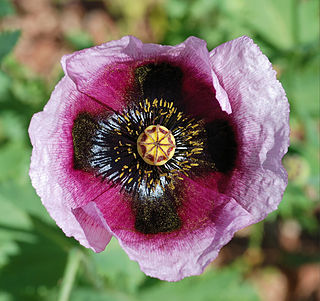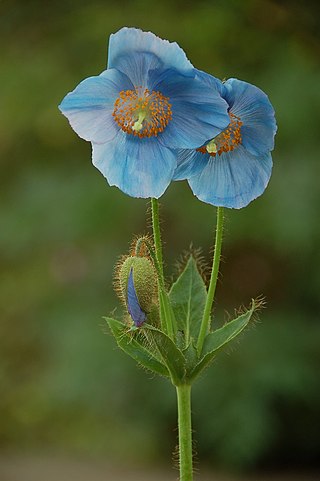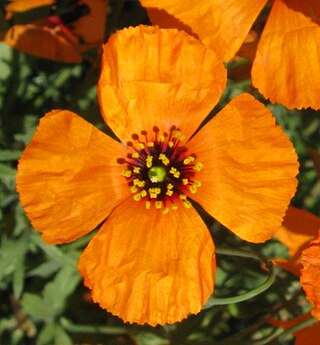
Eschscholzia californica, the California poppy, golden poppy, California sunlight or cup of gold, is a species of flowering plant in the family Papaveraceae, native to the United States and Mexico. It is cultivated as an ornamental plant flowering in summer, with showy cup-shaped flowers in brilliant shades of red, orange and yellow. It is also used as food or a garnish. It became the official state flower of California in 1903.

A poppy is a flowering plant in the subfamily Papaveroideae of the family Papaveraceae. Poppies are herbaceous plants, often grown for their colourful flowers. One species of poppy, Papaver somniferum, is the source of the narcotic drug mixture opium which contains powerful medicinal alkaloids such as morphine and has been used since ancient times as an analgesic and narcotic medicinal and recreational drug. It also produces edible seeds. Following the trench warfare in the poppy fields of Flanders, Belgium during World War I, poppies have become a symbol of remembrance of soldiers who have died during wartime, especially in the UK, Canada, Australia, New Zealand and other Commonwealth realms.

Ranunculales is an order of flowering plants. Of necessity it contains the family Ranunculaceae, the buttercup family, because the name of the order is based on the name of a genus in that family. Ranunculales belongs to a paraphyletic group known as the basal eudicots. It is the most basal clade in this group; in other words, it is sister to the remaining eudicots. Widely known members include poppies, barberries, hellebores, and buttercups.

Fumarioideae is a subfamily of the family Papaveraceae. It was formerly treated as a separate family, the Fumariaceae. It consists of about 575 species of herbaceous plants in 20 genera, native to the Northern Hemisphere and South Africa. The largest genus is Corydalis.

Papaver rhoeas, with common names including common poppy, corn poppy, corn rose, field poppy, Flanders poppy, and red poppy, is an annual herbaceous species of flowering plant in the poppy family Papaveraceae. It is native to north Africa and temperate Eurasia and is introduced into temperate areas on all other continents except Antarctica.

Papaver is a genus of 70–100 species of frost-tolerant annuals, biennials, and perennials native to temperate and cold regions of Eurasia, Africa and North America. It is the type genus of the poppy family, Papaveraceae.

Papaver somniferum, commonly known as the opium poppy or breadseed poppy, is a species of flowering plant in the family Papaveraceae. It is the species of plant from which both opium and poppy seeds are derived and is also a valuable ornamental plant grown in gardens. Its native range was east of the Mediterranean Sea, but now is obscured by ancient introductions and cultivation, being naturalized across much of Europe and Asia.

Meconopsis is a genus of flowering plants in the poppy family Papaveraceae. It was created by French botanist Viguier in 1814 for the species known by the common name Welsh poppy, which Carl Linnaeus had described as Papaver cambricum. The genus name means "poppy-like". Himalayan species discovered later were also placed in Meconopsis. In the 21st century, it was discovered that the Himalayan species were less closely related to the Welsh poppy, which has been restored to Papaver. All species now placed in Meconopsis are native to the Himalayas and surrounding regions. They have attractive, usually blue flowers.

Papaver cambricum, synonym Meconopsis cambrica, the Welsh poppy, is a perennial flowering plant in the poppy family Papaveraceae. It has yellow to orange flowers and is widely grown as a garden plant. It is a native of damp, rocky sites in upland areas of Western Europe from the British Isles to the Iberian Peninsula. It has been used since 2006 as the basis for the logo of the political party Plaid Cymru.

Poppy tea is an herbal tea infusion brewed from poppy straw or seeds of several species of poppy. The species most commonly used for this purpose is Papaver somniferum, which produces opium as a natural defense against predators. In the live flower, opium is released when the surface of the bulb, called the seed pod, is pierced or scraped. For the purpose of the tea, dried pods are more commonly used than the pods of the live flower. The walls of the dried pods contain opiate alkaloids, primarily consisting of morphine.

Roemeria argemone is a species of flowering plant in the poppy family Papaveraceae. Its common names include long pricklyhead poppy, prickly poppy and pale poppy. Its native range includes parts of Eurasia and North Africa, but it can be found growing wild in parts of North America, where it is an introduced species. It is cultivated as an ornamental plant.

Meconic acid, also known as acidum meconicum and poppy acid, is a chemical substance found in certain plants of the poppy family, Papaveraceae, such as Papaver somniferum and Papaver bracteatum. Meconic acid constitutes about 5% of opium and can be used as an analytical marker for the presence of opium. Meconic acid has erroneously been described as a mild narcotic, but it has little or no physiological activity, and is not used medicinally. Meconic acid forms salts with alkaloids and metals. These salts as well as meconic acid esters are called meconates. Meconic acid was first isolated by Friedrich Sertürner in 1805.

Corydalis nobilis, the Siberian corydalis, is a perennial plant native to Siberia, Xinjiang and Kazakhstan. It was introduced to Europe by Linnaeus, who had asked his friend Erich Laxmann for seeds of Lamprocapnos spectabilis, but was sent seeds of C. nobilis instead. Both Lamprocampnos and Corydalis are members of the family Papaveraceae, with seeds having an attached elaiosome that makes them attractive to ants, which disperse the seeds.

Papaver setigerum, common name poppy of Troy or dwarf breadseed poppy, is a herbaceous annual plant of the family Papaveraceae.

Chelidonine is an isolate of Papaveraceae with acetylcholinesterase and butyrylcholinesterase inhibitory activity.

Papaveroideae is a subfamily of the family Papaveraceae.

Isoquinoline alkaloids are natural products of the group of alkaloids, which are chemically derived from isoquinoline. They form the largest group among the alkaloids.

Papaver heterophyllum, previously known as Stylomecon heterophylla, and better known as the wind poppy, is a winter annual herbaceous plant. It is endemic to the western California Floristic Province and known to grow in the area starting from the San Francisco Bay Area of Central Western California southwards to northwestern Baja California, Mexico. Its main habitat is often described as mesic and shady, with loamy soils such as soft sandy loam, clay loam, and leaf mold loam.

Oreomecon is a genus in the poppy family Papaveraceae. It was established in 2022 for what was previously treated as Papaver sect. Meconella in order to ensure that the genus Papaver was monophyletic. As of June 2023, names in the genus Oreomecon had only been published for better known and phylogenetically understood species present in Europe, either as natives or aliens.






















































